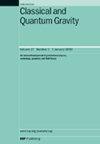慢旋转玻色子恒星的新方法
IF 3.7
3区 物理与天体物理
Q2 ASTRONOMY & ASTROPHYSICS
引用次数: 0
摘要
我们提出了在“慢旋转”近似中表示玻色子星(BSs)的爱因斯坦-克莱因-戈登(EKG)系统的解决方案,其中度规的形式相对于球对称问题,主要通过包含拖曳项gtφ来修改,而度规分量是与角度无关的。另一方面,产生BS的复值标量场保持角度依赖,但为了在求解EKG系统时保持自洽性,这种依赖在爱因斯坦场方程中被平均掉。场的拓扑结构是环面,与球对称处理有很大的不同。在这些近似下,我们能够降低方程的复杂性,得到一个常微分方程组,它可以方便地在数值上求解,而不需要昂贵的计算资源。我们找到了解的序列,并描述了它们的一些物理(整体)性质,如总质量、角动量和紧致度。我们将我们的结果与完全旋转非线性问题(在保持平稳、轴对称和圆形假设的情况下,在方程中不进行近似)进行比较,并显示我们的近似的有效性区域。值得注意的是,我们表明,当限制到旋转BS的最低(量子)数时,这些物理性质在最坏情况下与完全处理相比差异高达23%。最后,我们分析了粒子(测地线)在由此产生的时空中的动力学,并将我们的结果与完全非线性问题进行了比较。本文章由计算机程序翻译,如有差异,请以英文原文为准。
A novel approach for slowly rotating boson stars
We present solutions to the Einstein–Klein–Gordon (EKG) system representing boson stars (BSs) in the ‘slow rotation’ approximation where the form of the metric, relative to the spherically symmetric problem, is mainly modified by the inclusion of the dragging term gtϕ while the metric components are angle independent. On the other hand, the complex-valued scalar field that source the BS is kept angle dependent, but in order to maintain the self-consistency when solving the EKG system, this dependency is averaged out in the Einstein field equations. The topology of the field is toroidal and differs drastically from the spherically symmetric treatment. Under these approximations we are able to reduce the complexity of the equations yielding a system of ordinary differential equations that is conveniently solved numerically without the need of expensive computational resources. We find sequences of solutions and describe some of their physical (global) properties such as, total mass, angular momentum and compactness. We compare our results with the fully rotating non-linear problem (where no approximations are made in the equations while keeping the stationarity, axisymmetry and circularity hypothesis) and show the region of validity of our approximation. Notably, we show that those physical properties differ in the worst scenarios up to 23% relative to the full treatment when restricting to the lowest (quantum) numbers for the rotating BS. Finally, we analyze the dynamics of particles (geodesics) in the resulting spacetime and compare our results with the full non-linear problem.
求助全文
通过发布文献求助,成功后即可免费获取论文全文。
去求助
来源期刊

Classical and Quantum Gravity
物理-天文与天体物理
CiteScore
7.00
自引率
8.60%
发文量
301
审稿时长
2-4 weeks
期刊介绍:
Classical and Quantum Gravity is an established journal for physicists, mathematicians and cosmologists in the fields of gravitation and the theory of spacetime. The journal is now the acknowledged world leader in classical relativity and all areas of quantum gravity.
 求助内容:
求助内容: 应助结果提醒方式:
应助结果提醒方式:


